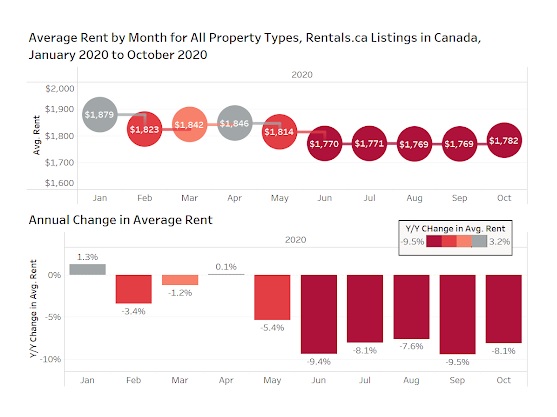New rental data for October 2020 shows that average rents are down in most large metros, particularly for smaller luxury units located in busy downtown neighbourhhoods.
In Toronto, rents have declined 17 per cent for a one-bedroom home and 14 per cent for a two-bedroom home; in Montreal, however, rents are up 15 per cent for a one-bedroom and 9 per cent for a two-bedroom.
Trending since the pandemic began in March, tenants have been seeking out rental units close to grocery stores and parks, as opposed to busy high density neighbourhoods close to office towers.
The average rent for all Canadian properties in October 2020 increased slightly over September (0.7 per cent) to $1,782, after four months of almost no change, according to the latest data from Rentals.ca and Bullpen Research & Consulting. Year over year, the average rent for all property types listed on Rentals.ca is still down but improving.
 “The average rent in Canada trended up in October, which we partially attribute to an increase in new purpose-built rental apartment listings,” said Matt Danison, CEO of Rentals.ca. “We continue to see an increase in listings nationally, which tells us that supply is outpacing demand. This market imbalance suggests soft rental market conditions will continue for the rest of the year.”
“The average rent in Canada trended up in October, which we partially attribute to an increase in new purpose-built rental apartment listings,” said Matt Danison, CEO of Rentals.ca. “We continue to see an increase in listings nationally, which tells us that supply is outpacing demand. This market imbalance suggests soft rental market conditions will continue for the rest of the year.”
Average rent in specific GTA cities
North York finished first among 35 cities for highest average monthly rent in October 2020, surpassing both Toronto and Vancouver due to a number of new purpose-built apartments beginning pre-leasing programs, which pulled the average up. Month over month, average rent for a one-bedroom in North York was up 7 per cent ($1,945) and 12.4 per cent ($2,459) for a two-bedroom.
Mississauga finished fourth on the list for average monthly rent for a one-bedroom home ($1,877) and seventh for average monthly rent for a two-bedroom ($2,150). Year over year, rents are down for both unit sizes in Mississauga, at 5.6 per cent and 10.2 per cent respectively.
Etobicoke finished fifth for average monthly rent for a one-bedroom ($1,861) and fourth for average monthly rent for a two-bedroom ($2,306). Year over year, average monthly rent was down 9.1 per cent for a one-bedroom and 8.9 per cent for a two-bedroom.
Rising rents in secondary markets
As several of Canada’s major cities continue to see declining rental rates, many secondary markets are seeing rents increase. Demand is down and supply is up overall, but demand is shifting geographically.
Data backs up the “Urban Exodus” theory in Ontario, with average rents declining in places like North York, Etobicoke, Toronto and East York, while cities such as Kitchener, Hamilton and London are still seeing double-digit rent growth with annual increases of 14 per cent, 15 per cent and 17 per cent respectively.
As more tenants work from home, less expensive units in smaller communities are drawing attention. Municipalities in Ontario with the biggest growth in pageviews on Rentals.ca are: Kingston, Guelph, Windsor, Barrie, Cambridge, Whitby, Brantford, Hamilton, Burlington and Woodstock.
“The rising rents in several smaller municipalities, as well as the significant increase in web traffic on Rentals.ca in Ontario suggests many prospective tenants are widening their search area when looking for a rental property,” said Ben Myers, president of Bullpen Research & Consulting, “With many choosing to go back to where they grew up or attended university to avoid the lofty Toronto area rental rates.”
Vancouver
Like Toronto, rents for condominium and rental apartments in Vancouver have declined year over year with one-bedroom suites down 3 per cent and two-bedroom suites down 6 per cent.
Meanwhile things are looking good in Montreal, where year-over-year average monthly rents are up 15 per cent for a one-bedroom and 9 per cent for a two-bedroom.







